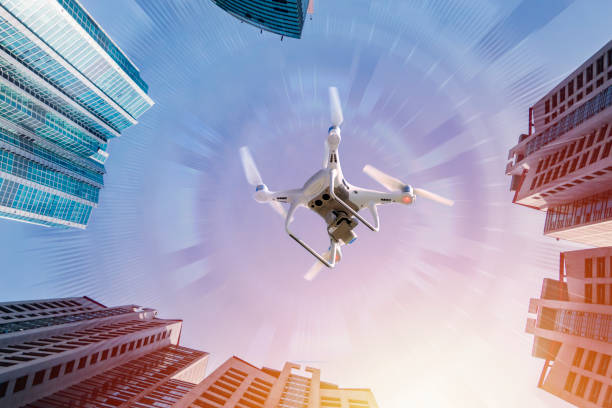Drones in Action: Aerial Technology Redefining Industries
In the realm of technology, drones have emerged as versatile aerial tools, transcending their initial use for recreational purposes. From agriculture and infrastructure inspection to emergency response and filmmaking, drones are reshaping industries by providing unprecedented perspectives and capabilities. The advent of drone technology signifies a paradigm shift in how we approach various tasks, offering efficiency, cost-effectiveness, and safety in sectors that range from agriculture to healthcare. This article explores the diverse applications of drones, their impact on industries, and the transformative potential they hold for the future.
The Evolution of Drone Technology
Drones, also known as Unmanned Aerial Vehicles (UAVs) or Unmanned Aircraft Systems (UAS), have a history rooted in military applications. However, their evolution into accessible, versatile tools for civilian use has been rapid and transformative. The key elements driving this evolution include:
- Advancements in Technology:
Miniaturization: Technological advancements have led to the miniaturization of key components, allowing for the development of smaller and more agile drones.Battery Technology: Improved battery technology has extended flight times, enabling drones to cover larger areas and accomplish more complex tasks.
- Affordability and Accessibility:
Consumer Drones: The availability of affordable consumer drones has democratized aerial technology. Individuals and businesses can now harness the power of drones without significant financial barriers.
- Enhanced Sensors and Imaging:
High-Resolution Cameras: Drones are equipped with high-resolution cameras, thermal imaging, LiDAR (Light Detection and Ranging), and other sensors, enabling diverse applications such as surveying, mapping, and surveillance.
- Regulatory Frameworks:
Drone Regulations: The establishment of regulatory frameworks for drone operations has played a crucial role in ensuring safe and responsible use. Governments worldwide have implemented guidelines to govern drone flights and protect airspace.
Applications of Drones Across Industries
- Agriculture:
Precision Agriculture: Drones equipped with sensors and imaging technology are used for precision agriculture. They monitor crop health, assess soil conditions, and optimize irrigation, leading to increased crop yields and resource efficiency.Crop Spraying: Drones can efficiently spray pesticides and fertilizers over agricultural fields. This targeted approach reduces the environmental impact and enhances the effectiveness of crop treatments.
- Infrastructure Inspection:
Power Line and Pipeline Inspection: Drones are employed for inspecting power lines, pipelines, and other critical infrastructure. They can navigate challenging terrain and capture high-resolution images for assessing the condition of assets.Bridge and Building Inspections: Drone technology is utilized for inspecting bridges, buildings, and other structures. Drones equipped with cameras and sensors can access hard-to-reach areas, reducing the need for risky manual inspections.
- Emergency Response:
Search and Rescue Operations: Drones play a crucial role in search and rescue missions. Equipped with thermal imaging cameras and GPS technology, they can locate missing persons or assess disaster-stricken areas, providing valuable information to responders.Disaster Assessment: Drones are deployed in the aftermath of natural disasters to assess damage, map affected areas, and plan relief efforts. This real-time data aids emergency response teams in making informed decisions.
- Filmmaking and Photography:
Aerial Cinematography: Drones have revolutionized filmmaking by offering dynamic aerial shots. They can capture breathtaking landscapes, chase scenes, and intricate shots that were once challenging or impossible to achieve.Photography and Surveillance: Drones serve as valuable tools for aerial photography and surveillance. They provide a bird’s-eye view for photographers and enhance security by monitoring large areas from above.
- Delivery Services:
Drones in Action rone Deliveries: Some companies are exploring the use of drones for delivery services. Drones can transport small packages to remote or difficult-to-reach locations, offering a faster and more efficient alternative to traditional delivery methods.
- Environmental Monitoring:
Wildlife Conservation: Drones aid in wildlife conservation efforts by monitoring endangered species, tracking animal populations, and surveying ecosystems. This non-intrusive approach reduces disturbances to wildlife.Forest Management: Drones equipped with sensors can monitor forests for signs of illegal logging, assess tree health, and contribute to forest management and conservation efforts.
Impact on Industries
- Increased Efficiency:
Time and Cost Savings: Drones enable quick and cost-effective data collection. In industries such as agriculture, infrastructure inspection, and filmmaking, the speed and efficiency of drone operations translate into significant time and cost savings.
- Enhanced Safety:
Reduced Human Risk: Drones play a crucial role in tasks that involve inherent risks to human safety, such as inspecting tall structures, monitoring disaster-stricken areas, or conducting search and rescue operations.
- Data Precision:
High-Resolution Imaging: The high-resolution cameras and sensors on drones provide precise and detailed data. This accuracy is invaluable in applications such as agriculture, where precise information about crop health and soil conditions is essential.
- Accessibility:
Remote Areas: Drones provide access to remote or difficult-to-reach areas, making them indispensable in industries such as environmental monitoring, wildlife conservation, and emergency response.
- Innovation and New Possibilities:
Business Innovation: The integration of drones has sparked innovation in various industries. Businesses are exploring new ways to leverage aerial technology, leading to the development of novel applications and services.
Challenges and Considerations
- Regulatory Compliance:
Adherence to Regulations: Navigating and complying with evolving drone regulations is a challenge for businesses and individuals. Strict adherence is essential to ensure safe and responsible drone operations.
- Privacy Concerns:
Data Privacy: The use of drones, especially in urban areas, raises concerns about privacy. Striking a balance between the benefits of drone technology and protecting individual privacy is a critical consideration.
- Security Risks:
Unauthorized Use: The potential for unauthorized drone use poses security risks. This includes concerns about drones flying in restricted airspace, as well as the risk of malicious use for surveillance or other nefarious purposes.
- Air Traffic Management:
Integration into Airspace: The integration of drones into manned airspace requires effective air traffic management systems. Coordination between drones and traditional aviation is crucial to avoid collisions and ensure safety.
- Limited Payload Capacity:
Payload Limitations: Drones often have limited payload capacity, restricting their ability to carry heavy equipment or perform tasks that require specialized tools. Advances in drone design and technology are addressing these limitations.
Future Trends and Innovations
- Autonomous Drones:
Automated Operations: The development of autonomous drones capable of performing tasks without human intervention is a key trend. These drones can navigate complex environments, make decisions based on real-time data, and optimize their operations.
- Swarm Technology:
Drones in Action: Swarm technology involves the coordinated operation of multiple drones to perform tasks collaboratively. This approach has applications in agriculture, search and rescue, and environmental monitoring.
- AI and Machine Learning Integration:
Intelligent Drones: The integration of Artificial Intelligence (AI) and machine learning enhances the capabilities of drones. Intelligent drones can analyze data on the fly, adapt to changing conditions, and improve their performance over time.
- Extended Flight Times:
Advanced Battery Technology: Ongoing advancements in battery technology aim to extend drone flight times. Longer flight durations increase the range of applications and make drones more versatile.
- Urban Air Mobility:
Personal Aerial Vehicles: The concept of urban air mobility involves the development of personal aerial vehicles for short-distance transportation within urban areas. These vehicles, often based on drone technology, could revolutionize urban commuting.
Conclusion
Drones in Action once associated primarily with military applications, have become integral to diverse industries, offering innovative solutions to age-old challenges. Their ability to provide aerial perspectives, collect precise data, and perform tasks in a safe and efficient manner is transforming the way we approach agriculture, infrastructure inspection, emergency response, and more. As drone technology continues to evolve, addressing regulatory, privacy, and security considerations will be crucial for realizing its full potential. The future promises a landscape where drones seamlessly integrate into daily operations, offering solutions that are not only efficient and cost-effective but also contribute to the advancement of industries and the well-being of society as a whole. The sky is not the limit; it’s the starting point for a future where drones in action redefine the way we live and work







[…] Skills: A solid understanding of analytics is fundamental in digital marketing. Marketers need to interpret data from various […]